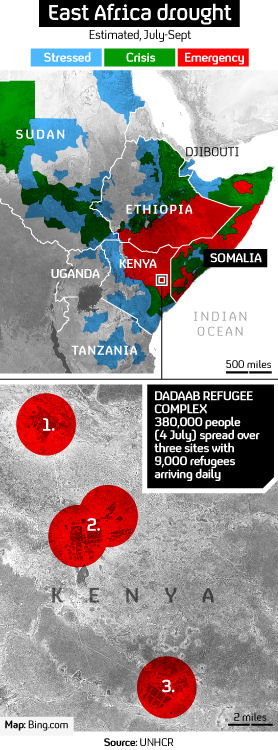Pleas for aid as Africa drought sparks crisis
Ten million people across the Horn of Africa are being affected by the worst drought in 60 years. At the world’s largest refugee camp, aid agencies tell Channel 4 News people are facing desperation.
After two seasons of failed rains, East African countries are facing one of the worst droughts in decades as crops fail and food prices rocket.
Somalia, Djibouti, Ethiopia, Kenya and Uganda are all affected, with the situation deteriorating to the point of famine in some areas, the UN has warned.
Britain on Monday announced it was to pledge food for 1.3 million starving Ethiopians as hundreds of thousands face starvation in the next three months – the year’s driest period.
“Through no fault of its own, the Horn of Africa is experiencing a severe drought caused by the failed rains,” International Development Secretary Andrew Mitchell said as he pledged the cash to the World Food Programme.
“The country has made great strides in many areas over the past 30 years and this emergency relief will help to ensure that these gains are not eroded.”
Dangerously malnourished
More than a quarter of children in the worst-hit parts of Kenya are now dangerously malnourished, and in Somalia malnutrition rates have reached 30 per cent in some areas, making East Africa one of the hungriest places on earth.
Across the Horn of Africa, tens of thousands of Somalis are fleeing. Since the beginning of the year 55,000 have fled into Ethiopia where more than 50 per cent are malnourished.
A UN Refugee Agency spokesman told Channel 4 News the situation was “getting unbearable”.
In recent weeks the world’s biggest refugee agency in Kenya has seen an influx of people seeking food and shelter as desperation spreads and many flee violence and drought in Somalia.
The Dadaab refugee camp was built 20 years ago with a capacity of 90,000 people – it now homes four times that with more than 1,000 people arriving every day.
According to the latest figures collated by the UN Refugee Agency, a total of 382,000 people now reside at the sprawling camp – Kenya’s third largest ‘city’ which has a bigger population than Italy’s Florence.
“Ordinarily we’d expect to see around 4,000-5,000 people a month arrive at the camp. In recent weeks we’ve been seeing that many people arrive in three days,” Andrew Wander from Save the Children told Channel 4 News from Dadaab.
“We’re looking at 1,500 people a day arriving.”

Pleas for help
Mr Wander told Channel 4 News that people had been forced to make a “journey of desperation” walking weeks at a time to cross the border into Kenya and reach the camp.
Many arrive from neighbouring Somalia, fleeing war, drought and soaring food prices. Some are forced to fight off wild animals on their journey – while others arrive too late to save their malnourished children.
“One mother from Somalia had six children with her,” said Andrew Wander.
“When she arrived at the Kenyan border the children were too weak to carry on and she couldn’t carry all six of them. She was forced to carry two to Dadaab, walked back to the border – a 70km walk – collected another two walked back to the camp, and then did the same again with her final two children.
“These are real stories of desperation – of tragedy.
“Oddly, these are the lucky people as they are getting some sort of help. There are thousands of other people in Somalia who haven’t made it to the camp. This is very much the tip of the iceberg in terms of the numbers of people displaced in the country.”
On arrival at Dadaab, the journey is far from over as the influx of people means aid agencies are struggling to process new arrivals. Channel 4 News has been told that some have to wait between 10 and 30 days to be registered.
Fragile shelters spring up on the camp’s fringes made from branches and torn fabric.
An extension to one of the three camps which collectively makes up Dadaab is being extended but it lies half-built and empty as negotiations breakdown between the UN and Kenyan authorities.
Numerous aid agencies have launched appeals for aid to help those affected by the drought and continuing refugee crisis.